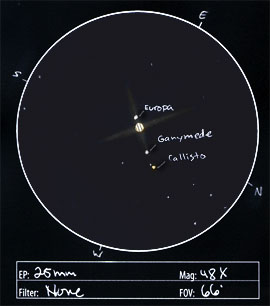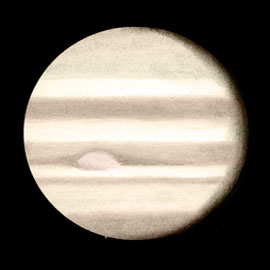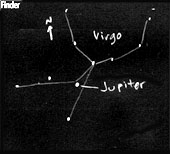

Observation Notes:
 This was my first official observation of Jupiter. It turns out to be a lot like observing a DSO–lots of time and averted vision. Part of that may be because planetary contrast is low in my scope, but the seeing was also horrible. After some concentration, I got to see the Great Red Spot! Or perhaps it should be called the Great Pink Spot. It was very subtle. The disc was a pale cream, the main equatorial cloud bands were light brown, and the GRS was a bit peachier in color and lighter than the cloud band bracketing it. The southern equatorial band seemed darker where it swirled around the huge storm. The northern equatorial band was darker, and the norther polar region appeared as a broad cap only slightly darker than the light band south of it. South of the GRS, there was a gap, and then a thin dark band. Below this band, a lighter region led into a dark southern cap. This was too cool. The east side seemed to have a soft gradation to shadow–maybe a 95% phase?
This was my first official observation of Jupiter. It turns out to be a lot like observing a DSO–lots of time and averted vision. Part of that may be because planetary contrast is low in my scope, but the seeing was also horrible. After some concentration, I got to see the Great Red Spot! Or perhaps it should be called the Great Pink Spot. It was very subtle. The disc was a pale cream, the main equatorial cloud bands were light brown, and the GRS was a bit peachier in color and lighter than the cloud band bracketing it. The southern equatorial band seemed darker where it swirled around the huge storm. The northern equatorial band was darker, and the norther polar region appeared as a broad cap only slightly darker than the light band south of it. South of the GRS, there was a gap, and then a thin dark band. Below this band, a lighter region led into a dark southern cap. This was too cool. The east side seemed to have a soft gradation to shadow–maybe a 95% phase?
Three out of four moons were visible: Europa was close to Jupiter, just to the east. Ganymede was about 4 times further out, to the west, and Callisto–appearing the ruddiest of the 3–was the furthest west. Io was eclipsed behind Jupiter. There was a star that shone very close and to the south of Callisto–at first I wondered if I was seeing one of Jupiter’s dimmer moons, but further research proves that to be a very unlikely find in a 6″ scope. A check of The Sky showed this star to be 9.7 magnitude GSC 4963:355.
| Subject | Jupiter |
| Classification | Planet |
| Position* | Virgo [RA: 13:07.4 / Dec: -05:30] |
| Size* | 42.6″ (Equatorial diameter) |
| Brightness* | -2.4 |
| Date/Time | March 2, 2005 – 12:30 AM (March 2, 2005 – 07:30 UT) |
| Observing Loc. | Flagstaff, AZ – Home |
| Instrument | Orion SVP 6LT Reflector (150 mm dia./1200 mm F/L) |
| Eyepieces/Mag. | 25 mm Sirius Plössl (48X), 10 mm Sirius Plössl+ 2X Barlow (240X) |
| Conditions | Clear, 32°F, some high thin clouds |
| Seeing | 3/10 |
| Transparency | Mag 5.2 NELM |
| *Sources | Orion’s The Sky Astronomy Software |
Sketch of Jupiter at 48X
Sketch of Jupiter at 240X
Observation Notes:
Finder view of Jupiter
This was my first official observation of Jupiter. It turns out to be a lot like observing a DSO–lots of time and averted vision. Part of that may be because planetary contrast is low in my scope, but the seeing was also horrible. After some concentration, I got to see the Great Red Spot! Or perhaps it should be called the Great Pink Spot. It was very subtle. The disc was a pale cream, the main equatorial cloud bands were light brown, and the GRS was a bit peachier in color and lighter than the cloud band bracketing it. The southern equatorial band seemed darker where it swirled around the huge storm. The northern equatorial band was darker, and the norther polar region appeared as a broad cap only slightly darker than the light band south of it. South of the GRS, there was a gap, and then a thin dark band. Below this band, a lighter region led into a dark southern cap. This was too cool. The east side seemed to have a soft gradation to shadow–maybe a 95% phase?
Three out of four moons were visible: Europa was close to Jupiter, just to the east. Ganymede was about 4 times further out, to the west, and Callisto–appearing the ruddiest of the 3–was the furthest west. Io was eclipsed behind Jupiter. There was a star that shone very close and to the south of Callisto–at first I wondered if I was seeing one of Jupiter’s dimmer moons, but further research proves that to be a very unlikely find in a 6″ scope. A check of The Sky showed this star to be 9.7 magnitude GSC 4963:355.
| Subject | Jupiter |
| Classification | Planet |
| Position* | Monoceros [RA: 13:07.4 / Dec: -05:30] |
| Size* | 42.6″ (Equatorial diameter) |
| Brightness* | -2.4 |
| Date/Time | March 2, 2005 – 12:30 AM (March 2, 2005 – 07:30 UT) |
| Observing Loc. | Flagstaff, AZ – Home |
| Instrument | Orion SVP 6LT Reflector (150 mm dia./1200 mm F/L) |
| Eyepieces/Mag. | 25 mm Sirius Plössl (48X), 10 mm Sirius Plössl+ 2X Barlow (240X) |
| Conditions | Clear, 32°F, some high thin clouds |
| Seeing | 3/10 |
| Transparency | Mag 5.2 NELM |
| *Sources | Orion’s The Sky Astronomy Software |